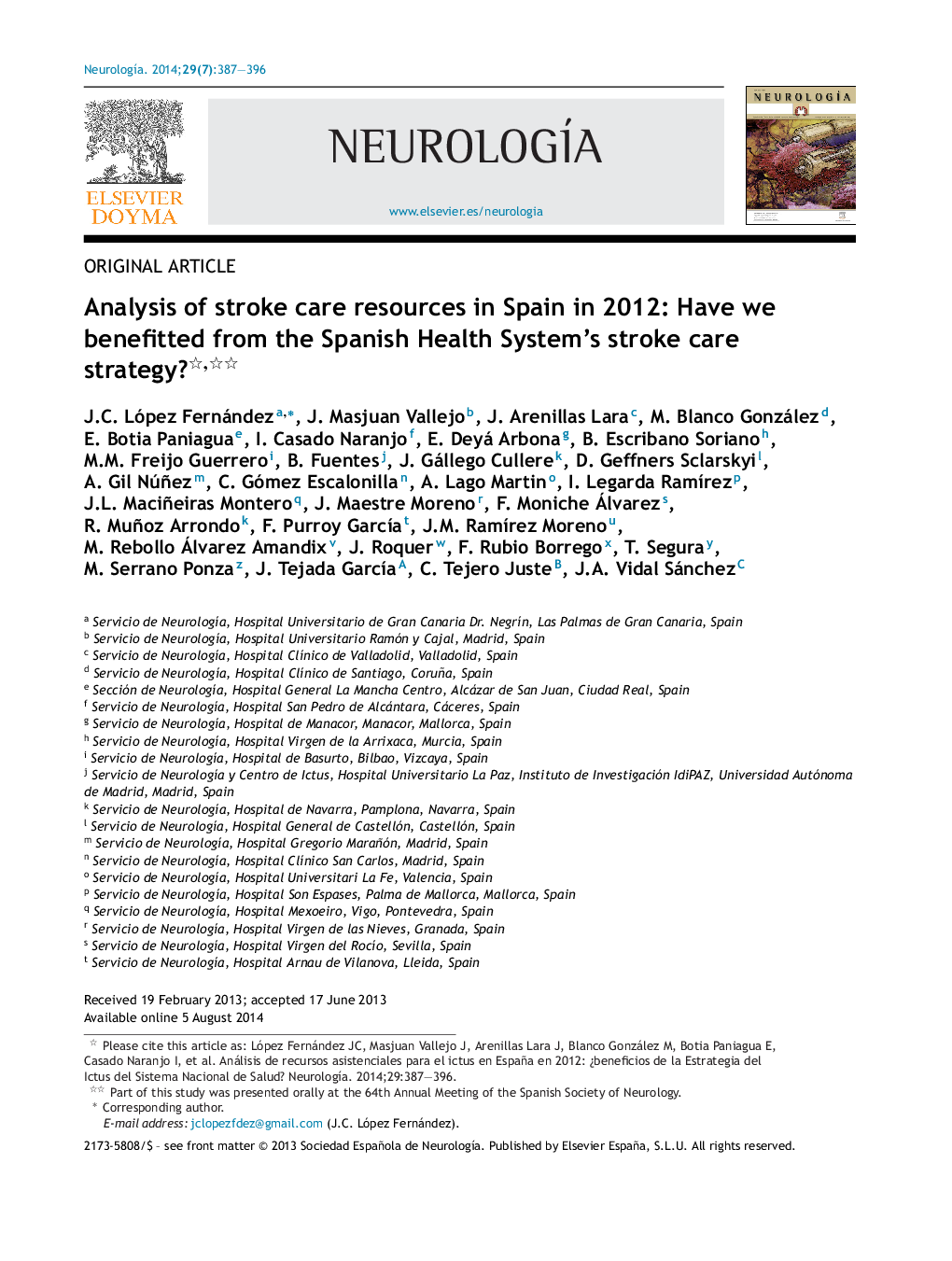| کد مقاله | کد نشریه | سال انتشار | مقاله انگلیسی | نسخه تمام متن |
|---|---|---|---|---|
| 3077262 | 1189131 | 2014 | 10 صفحه PDF | دانلود رایگان |
IntroductionThe Spanish Health System's stroke care strategy (EISNS) is a consensus statement that was drawn up by various government bodies and scientific societies with the aim of improving quality throughout the care process and ensuring equality among regions. Our objective is to analyse existing healthcare resources and establish whether they have met EISNS targets.Material and methodsThe survey on available resources was conducted by a committee of neurologists representing each of Spain's regions; the same committee also conducted the survey of 2008. The items included were the number of stroke units (SU), their resources (monitoring, neurologists on call 24 hours/7 days, nurse ratio, protocols), SU bed ratio/100 000 inhabitants, diagnostic resources (cardiac and cerebral arterial ultrasound, advanced neuroimaging), performing intravenous thrombolysis, neurovascular interventional radiology (neuro VIR), surgery for malignant middle cerebral artery (MCA) infarctions and telemedicine availability.ResultsWe included data from 136 hospitals and found 45 Stroke Units distributed unequally among regions. The ratio of SU beds to residents ranged from 1/74 000 to 1/1 037 000 inhabitants; only the regions of Cantabria and Navarre met the target. Neurologists performed 3237 intravenous thrombolysis procedures in 83 hospitals; thrombolysis procedures compared to the total of ischaemic strokes yielded percentages ranging from 0.3% to 33.7%. Hospitals without SUs showed varying levels of available resources. Neuro VIR is performed in every region except La Rioja, and VIR is only available on a 24 hours/7 days basis in 17 cities. Surgery for malignant MCA infarction is performed in 46 hospitals, and 5 have telemedicine.ConclusionStroke care has improved in terms of numbers of participating hospitals, the increased use of intravenous thrombolysis and endovascular procedures, and surgery for malignant MCA infarction. Implementation of SUs and telemedicine remain insufficient. The availability of diagnostic resources is good in most SUs and irregular in other hospitals. Regional governments should strive to ensure better care and territorial equality, which would achieve the EISNS objectives.
ResumenIntroducciónLa Estrategia del Ictus del Sistema Nacional de Salud (EISNS) fue un documento de consenso entre las distintas administraciones y sociedades científicas que se desarrolló con el objetivo de mejorar la calidad del proceso asistencial y garantizar la equidad territorial. Nuestro objetivo fue analizar los recursos asistenciales existentes y si se había cumplido el objetivo de la EISNS.Material y métodosLa encuesta sobre los recursos disponibles se realizó por un comité de neurólogos de cada una de las comunidades autónomas (CC.AA), los cuales también realizaron la encuesta de 2008. Los ítems incluidos fueron el número de Unidades de Ictus (UI), su dotación (monitorización, neurólogo 24 h/7 días, ratio enfermería, protocolos), ratio cama UI/100.000 habitantes, recursos diagnósticos (ecografía cardíaca y arterial cerebral, neuroimagen avanzada), realización de trombolisis intravenosa, intervencionismo neurovascular (INV), cirugía del infarto maligno de la arteria cerebral media (ACM) y disponibilidad de la telemedicina.ResultadosSe incluyeron datos de 136 hospitales. Existen 45 UI distribuidas de un modo desigual. La relación cama de UI por habitantes y comunidad autónoma osciló entre 1/74.000 a 1/1.037.000 habitantes, cumpliendo el objetivo solo Cantabria y Navarra. Se realizaron por neurólogos 3.237 trombolisis intravenosas en 83 hospitales, con un porcentaje respecto del total de ictus isquémico entre el 0,3 y el 33,7%. Los hospitales sin UI tenían una disponibilidad variable de recursos. Se realiza INV en todas las CC.AA salvo La Rioja, la disponibilidad del INV 24 h/7 días solo existe en 17 ciudades. Hay 46 centros con cirugía del infarto maligno de la ACM y 5 con telemedicina.ConclusiónLa asistencia al ictus ha mejorado en cuanto al incremento de hospitales participantes, la mayor aplicación de trombolisis intravenosa y procedimientos endovasculares, también en la cirugía del infarto maligno de la ACM, pero con insuficiente implantación de UI y de la telemedicina. La disponibilidad de recursos diagnósticos es buena en la mayoría de las UI, e irregular en el resto de hospitales. Las distintas CC.AA deben avanzar para garantizar el mejor tratamiento y equidad territorial, y así conseguir el objetivo de la EISNS.
Journal: Neurología (English Edition) - Volume 29, Issue 7, September 2014, Pages 387–396
